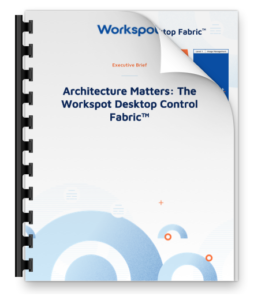Why Cloud Desktops? Why Now?
Why consider cloud desktops? It’s simple. Cloud desktops transform companies. Transformations are not small. A transformation is “a thorough or dramatic change in form or appearance.” Old-school virtual desktop infrastructure (VDI) never delivered the kind of transformation I’m referring to here, but cloud desktops do.
Cloud Desktops Transform Companies
“Transformation” is yet another overused word (much like “agility” – which I’ll use in a moment!). But cloud desktops drive the kind of transformation that creates new opportunities for companies to grow.
- Cloud desktops make companies better, giving them greater agility to respond to new opportunities.
- Cloud desktops make supporting remote work easy, whether people use them as their “every day” desktop or cloud desktops are activated in minutes and used during a business disruption.
- Cloud desktops simplify IT processes, so enterprises can make better use of these valuable people.
- Cloud desktops improve collaboration within enterprises and across joint venture project teams, improving time-to-market, product quality, and customer outcomes.
- Cloud desktops enable companies to hire the best people for the job, no matter where they are located.
- Cloud desktops amaze the people who use them because the performance is so outstanding.
This all adds up to a powerful transformation that creates new opportunities, competitive advantage, and business growth.
3 Essential Cloud Desktop Evaluation Criteria
Time-to-value
It’s well-known that on-premises VDI implementations take months, if not years, to get right. It’s a big reason why so many deployments stalled. There’s just too much complexity to deal with, and that consumes valuable IT resources at a time when companies need to do more with less. Even some of the cloud desktop solutions you’ll encounter are not fast or easy to implement. They still require you to manage infrastructure, and they don’t scale easily when you need to respond fast. These are the problems the right cloud desktop solution should solve. Today, you can have an expectation that your fully custom cloud desktops will be live in a few weeks – often much faster. There’s no reason to settle for less. And when you need to react to a new business opportunity that requires adding resources, choose a solution that scales in minutes, across cloud regions, and make sure you’ll be able to manage all your cloud desktops globally through a single console.
Performance
We’ve talked a lot about performance over the years because we know first-hand how slow-performing virtual desktops kill productivity. If all your users are right next to the datacenter where your virtual desktops live, performance might be fine. But that’s not the case with most enterprises; if you have employees and contractors all over the world, there’s no way they can all be close to their virtual desktop. These remote people are going to have a tough time, because latency is going to slow them down, and that slows down the business. Today you have massive public cloud scale at your fingertips. With Microsoft Azure, you essentially have 56+ data centers (and someone else manages them for you!), so you can locate virtual desktops in the cloud region that is closest to your users. Know what that means? Outstanding performance that keeps users happy and productive.
Service Level Agreement (SLA)
CIOs are smartly moving away from on-premises data centers because they are so resource-intensive to run, and that resource consumption is simply not strategic to the business. The same holds true for managing physical PCs and on-premises virtual desktops. The management effort and cost of provisioning, shipping, updating, and refreshing physical PCs or micro-managing VDI isn’t worth it when there are better options. Valuable IT resources should be allocated to more strategic projects than never-ending hardware refreshes. Cloud desktops bring that opportunity. The right solution alleviates the IT team of the responsibility for the desktop SLA; the vendor should take that responsibility off IT’s plate. Maintenance and service updates should happen automatically, just as new features should be readily available too. Even more valuable is when the solution includes a big data engine that can provide performance insights and proactively alert your IT team of a potential problem. That goes well beyond the SLA of just the cloud desktop. When the vendor can provide deep monitoring and insight into the behavior of your systems, that supports your overall business SLA, and that gives you a competitive advantage.
Why Now?
In two words – business continuity. Most enterprises have solid BC plans, but in some cases, there may be room for improvement. An often overlooked scenario is if people can’t (or in the case of COVID-19, shouldn’t) go to the office where their PC is located. Whether it’s a natural disaster or a health emergency keeping them away, cloud desktops can address this type of business disruption and make sure everyone gets back to productivity fast. Here’s a recent blog that outlines how a few Workspot customers are ensuring business resilience.
To learn more about Workspot cloud desktop solutions, schedule a demo here.



